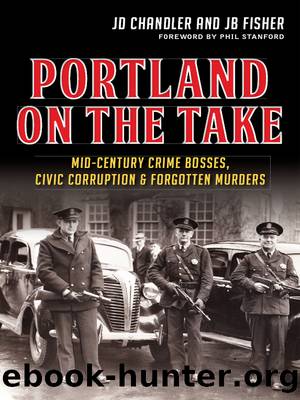Portland on the Take by JD Chandler

Author:JD Chandler
Language: eng
Format: epub
Publisher: Arcadia Publishing Inc.
Published: 2014-09-15T00:00:00+00:00
After Prohibition ended in 1933, the âspeakeasy cultureâ translated into the new ânightclub culture.â During World War II and after, a night on the town often included a visit to one or more nightclubs. Photograph by John Collier. Courtesy of the Library of Congress.
The Cecil Rooms were located on Southwest Sixth Avenue in the heart of downtown Portland. Patrons had to climb a flight of stairs and ring the buzzer to gain admittance to the two-story brick building. The door was kept locked, and the guests were viewed through a small window before being allowed entrance. The after-hours club employed a series of ârunnersâ who spread the word about where someone could âget a drink.â Also known as the 212 Club, the large room featured a bar, a jukebox, pinball, a piano and several tables surrounding a small dance floor. An adjoining room featured a large dice table. The kitchen was used by employees and only a select few guests. The Cecil Rooms didnât sell food and didnât have a liquor license. Upstairs were three rooms, one used by Pat OâDay and the others kept for favored guests and employees. OâDayâs room was sometimes used for assignations by the prostitutes who often frequented the club. In January 1947, two men lived in the rooms above the Cecil Club: Johnny Snyder, a young boxer who used the name Bobby Clark in the ring, and Jimmy Barr, who sang in the club and helped Johnny train. Pat OâDay often slept upstairs, although he had an apartment on Southwest Vista Drive. OâDay spent most of his time at the club, which served illegal alcohol nearly twenty-four hours a day.
The âbootlegâ clubs drew clients from all classes and occupations. Steered by ârunnersâ from the upscale nightclubsâor taxi drivers and pimpsâbusinessmen, middle-class couples on a night out, visitors from out of town, sailors and other transient workers looking for a drink rubbed elbows with safe-crackers, armed robbers, prostitutes and drug addicts. A regular cast of characters made the rounds of these clubs, and many of them preyed on the unwary visitors. Jimmy Barr, a bottom-of-the-barrel nightclub singer, and Lee Butler, an exâspecial police officer with a record for assault who played accordion, provided the entertainment at the Cecil Rooms. Sybil Willard and her roommate, Faye Tripp, made the rounds of bootleg clubs looking for opportunities. Willard was Pat OâDayâs âgirlfriend,â although some might have called her his punching bag. Barbara Daugherty ran the hatcheck concession and manned the door at the Cecil Rooms. Captain Frank Tatum was a frequent visitor to Portland since he captained a freight ship that made regular runs to Yokohama with grain cargos for famine-stricken Japan.
Captain Tatum had been in the Merchant Marine agency for more than twenty years and had seen a lot of action on liberty ships in the Atlantic during the war. When the war in Europe ended, he transferred to the Pacific and began to work out of Portland in 1945. In 1946, he took command of the SS Edwin Abbey, a former liberty ship sold by the Navy Department for civilian use.
Download
This site does not store any files on its server. We only index and link to content provided by other sites. Please contact the content providers to delete copyright contents if any and email us, we'll remove relevant links or contents immediately.
| Espionage | Hoaxes & Deceptions |
| Murder & Mayhem | Organized Crime |
| Serial Killers | White Collar Crime |
Mindhunter: Inside the FBI's Elite Serial Crime Unit by John E. Douglas & Mark Olshaker(9206)
Wiseguy by Nicholas Pileggi(5674)
Room 212 by Kate Stewart(5040)
Hitman by Howie Carr(5022)
Secrecy World by Jake Bernstein(4651)
Killers of the Flower Moon: The Osage Murders and the Birth of the FBI by David Grann(4387)
Papillon (English) by Henri Charrière(4199)
Breaking Free by Rachel Jeffs(4175)
Killers of the Flower Moon by David Grann(3971)
Say Nothing by Patrick Radden Keefe(3903)
American Kingpin by Nick Bilton(3759)
The Secret Barrister by The Secret Barrister(3615)
Molly's Game: From Hollywood's Elite to Wall Street's Billionaire Boys Club, My High-Stakes Adventure in the World of Underground Poker by Molly Bloom(3486)
Mysteries by Colin Wilson(3397)
In Cold Blood by Truman Capote(3311)
Signature in the Cell: DNA and the Evidence for Intelligent Design by Stephen C. Meyer(3075)
I'll Be Gone in the Dark by Michelle McNamara(3024)
Rogue Trader by Leeson Nick(2977)
Bunk by Kevin Young(2950)
